Have you ever wondered about the fascinating distinctions between Theravada and Mahayana Buddhism? These two major branches of Buddhism have unique characteristics that set them apart. Delve into the differences and uncover the contrasting beliefs, practices, scriptures, and views of enlightenment.
Key Takeaways:
- Theravada Buddhism focuses on the earliest Buddhist scriptures, while Mahayana incorporates new texts and teachings.
- Theravada emphasizes individual effort and monastic practice, while Mahayana focuses on helping others and a wider range of approaches to enlightenment.
- Theravada follows the Pali Canon, while Mahayana has its own canon and additional Mahayana sutras.
- Beliefs in Theravada Buddhism center around personal liberation, while Mahayana emphasizes the bodhisattva path and benefiting all beings.
- Enlightenment in Theravada is seen as liberation from samsara, while Mahayana views it as becoming a Buddha.
Diversity of Buddhism
Buddhism is a diverse and multifaceted religion that encompasses a wide range of traditions and practices. Within Buddhism, there exist various branches and schools that have developed over time, each with its own unique characteristics and teachings. Among the main branches of Buddhism, Theravada and Mahayana stand out as prominent examples with distinct approaches to spiritual practice and enlightenment.
Theravada Buddhism, also known as the “Teaching of the Elders,” is predominantly practiced in countries like Sri Lanka, Thailand, and Cambodia. This branch of Buddhism emphasizes the original teachings of the historical Buddha and places great importance on the monastic community. Theravada practitioners strive for personal liberation from the cycle of rebirth and suffering through meditation, self-discipline, and the diligent study of the Pali Canon.
Mahayana Buddhism, on the other hand, is prevalent in East Asian countries such as China, Japan, and Korea, as well as in the Tibetan region. Mahayana Buddhism, meaning “Great Vehicle,” encompasses a wide array of practices and beliefs. It emphasizes compassion, the pursuit of wisdom, and the aspiration to not only achieve personal enlightenment but to also help others attain liberation.
Three Main Types of Buddhism
Within Mahayana Buddhism, three significant forms have emerged:
- Theravada Buddhism: This branch, often referred to as Hinayana (“Lesser Vehicle”) by some Mahayana followers, places a strong emphasis on the individual’s pursuit of enlightenment through personal effort and discipline.
- Mayahana Buddhism: Mayahana encompasses various sub-schools and traditions, including Pure Land, Zen, and Tibetan Buddhism. It emphasizes the belief in multiple Buddhas and the aspiration to become a bodhisattva, an enlightened being committed to helping others attain liberation.
- Vajrayana Buddhism: Also known as Tibetan Buddhism, Vajrayana is a complex and esoteric form of Buddhism that incorporates teachings and practices from both Theravada and Mahayana. It is characterized by rituals, secret mantras, and the recognition of enlightened masters as spiritual guides.
The following table provides a summary of the three main types of Buddhism:
| Branch | Key Characteristics |
|---|---|
| Theravada Buddhism | Emphasizes personal liberation through meditation and self-discipline. |
| Mahayana Buddhism | Focuses on compassion, helping others attain liberation, and the belief in multiple Buddhas. |
| Vajrayana Buddhism | Incorporates elements of Theravada and Mahayana, with esoteric practices and the recognition of enlightened masters. |
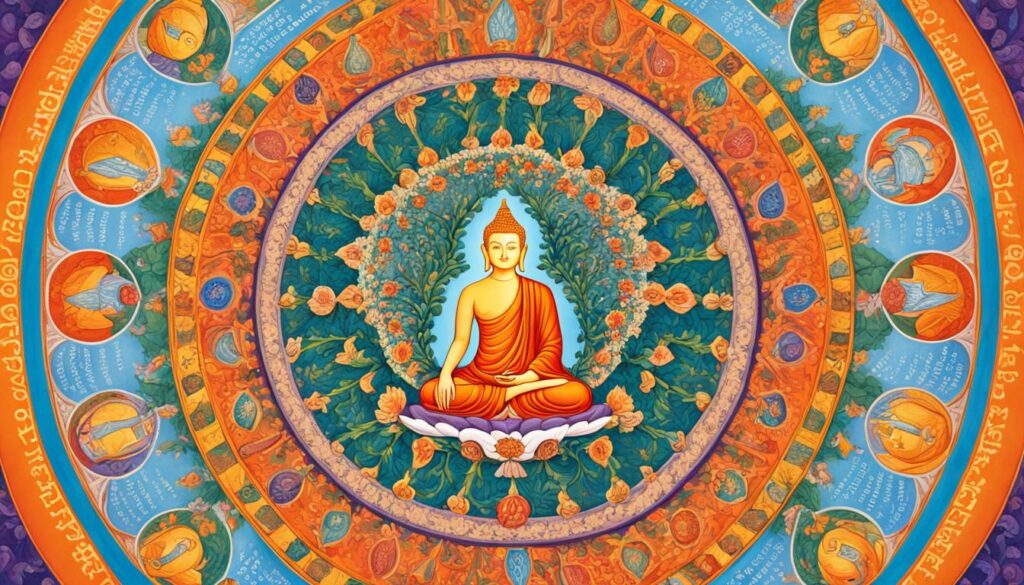
By understanding the diversity within Buddhism, we can gain a deeper appreciation for the different paths to enlightenment and the rich tapestry of spiritual practices that exist within this ancient tradition. Whether one follows Theravada, Mahayana, or Vajrayana Buddhism, the ultimate goal remains the same – the alleviation of suffering and the attainment of true peace and liberation.
Scriptures and Texts
One of the key differences between Theravada and Mahayana Buddhism lies in their scriptures and texts. These sacred writings form the foundation of each tradition, guiding their beliefs, practices, and understanding of enlightenment.
In Theravada Buddhism, the primary scripture is known as the Pali Canon. This collection of texts, also referred to as the Tipitaka, is written in the Pali language, which was the vernacular language of ancient India during the time of the Buddha. The Pali Canon is divided into three parts: the Vinaya Pitaka (rules and regulations for monastic discipline), the Sutta Pitaka (discourses of the Buddha), and the Abhidhamma Pitaka (philosophical and psychological analysis).
On the other hand, Mahayana Buddhism has its own canon of scriptures, which includes the Tripitaka and additional Mahayana sutras. While the Tripitaka is shared with Theravada, Mahayana places greater emphasis on the Mahayana sutras, which are considered to contain the profound teachings of the Buddha beyond what is found in the Pali Canon. These Mahayana sutras are mainly written in Sanskrit, the classical language of ancient India.
The scriptures in Theravada Buddhism, particularly the Pali Canon, are often regarded as the most authentic and closest to the original teachings of the Buddha. In contrast, Mahayana’s scriptures expand upon and reinterpret the earlier teachings, incorporating new perspectives and doctrines that resonate with the needs and aspirations of Mahayana practitioners.
The scriptures and texts in both traditions serve as a source of inspiration, guidance, and contemplation for Buddhists around the world. They offer profound insights into the nature of reality, the path to liberation, and the attainment of enlightenment.

Comparison of Scriptures in Theravada and Mahayana Buddhism:
| Theravada Buddhism | Mahayana Buddhism |
|---|---|
| Pali Canon (Tipitaka) | Tripitaka and Mahayana sutras |
| Written in Pali language | Written in Sanskrit language |
| Divided into three parts: Vinaya Pitaka, Sutta Pitaka, Abhidhamma Pitaka | Emphasis on Mahayana sutras that go beyond the Pali Canon |
| Regarded as the most authentic and closest to the original teachings of the Buddha | Expands upon and interprets the earlier teachings, incorporating new perspectives and doctrines |
Beliefs and Practices
When it comes to beliefs and practices, Theravada and Mahayana Buddhism differ in significant ways, offering unique paths to spiritual enlightenment. Theravada places a strong emphasis on the liberation of the individual from the cycle of samsara, which is achieved through personal effort and discipline.
On the other hand, Mahayana Buddhism centers around the bodhisattva path, in which individuals strive for enlightenment not only for themselves but also for the benefit of all beings. This compassionate approach reflects the Mahayana belief in the interconnectedness of all living beings.
Theravada Buddhism emphasizes meditation as a primary practice for developing mindfulness and insight. Monasticism is also highly valued in Theravada, with many individuals choosing to dedicate their lives to the pursuit of spiritual awakening within the monastic community. This disciplined and solitary path is focused on personal transformation.
Contrastingly, Mahayana Buddhism expands its practices to include a broader range of approaches. While meditation remains a vital component, Mahayana also incorporates selfless service and working for the benefit of others as integral practices. This compassionate engagement with the world is inspired by the bodhisattva ideal, where individuals aspire to alleviate the suffering of all sentient beings.

| Beliefs and Practices | Theravada Buddhism | Mahayana Buddhism |
|---|---|---|
| Focus | Individual liberation from samsara | Bodhisattva path for the benefit of all beings |
| Primary Practice | Meditation | Meditation, selfless service, and working for the benefit of others |
| Role of Monasticism | Highly valued, emphasis on personal discipline and transformation | Also present, but less prominent than in Theravada |
Concept of Enlightenment
The concept of enlightenment takes on distinct interpretations in Theravada and Mahayana Buddhism. In Theravada, enlightenment is viewed as the attainment of arhatship, signifying liberation from the cycle of rebirths, known as samsara. This state of ultimate liberation is achieved through individual effort, meditation, and adherence to the teachings of the Buddha.
On the other hand, Mahayana Buddhism perceives enlightenment as the realization of one’s own Buddha nature, embodying the qualities of compassion and wisdom. It is not solely for personal liberation but encompasses the aspiration to assist all sentient beings in attaining enlightenment. Becoming a Buddha, similar to the historical Buddha, is seen as the ultimate goal in Mahayana.
Both Theravada and Mahayana Buddhism acknowledge the profound transformative nature of enlightenment. The journey toward enlightenment, however, diverges in their emphasis and ultimate objectives.
Contrasting Views on Enlightenment
- Theravada Buddhism: Emphasizes the individual’s liberation from samsara through the attainment of arhatship.
- Mahayana Buddhism: Focuses on becoming a Buddha and assisting all sentient beings in achieving enlightenment.
Comparison of Enlightenment Goals
| Theravada Buddhism | Mahayana Buddhism |
|---|---|
| Attainment of arhatship | Becoming a Buddha and guiding others |
| Individual liberation | Compassionate service to all beings |
| Focus on personal effort | Commitment to the Bodhisattva path |
These differing perspectives on enlightenment offer unique paths for practitioners to explore and cultivate their spiritual growth. While Theravada emphasizes personal liberation, Mahayana embraces the responsibility to alleviate suffering and assist others in their pursuit of enlightenment. Understanding these contrasting concepts can inspire and guide individuals in their own spiritual journeys.
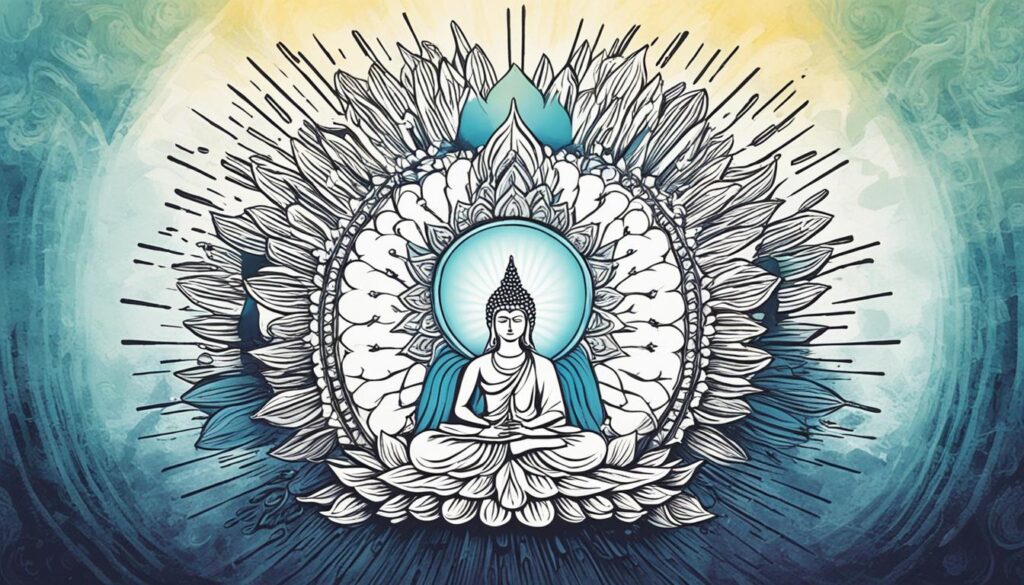
Role of Bodhisattvas
Bodhisattvas play a significant role in Mahayana Buddhism, embodying the compassionate ideal of postponing their own enlightenment to assist others in attaining liberation. The concept of the bodhisattva path is central to Mahayana teachings, emphasizing the commitment to alleviate the suffering of all beings. These beings, through their boundless compassion, work tirelessly to guide and support individuals along the path to enlightenment.
In Mahayana Buddhism, bodhisattvas are revered as noble beings who have reached advanced spiritual stages, characterized by wisdom and compassion. They serve as sources of inspiration and guidance for practitioners, showcasing the potential for enlightenment and the boundless capacity to help others. The role of the bodhisattva exemplifies the selfless dedication to the welfare of all sentient beings, embodying the core values of Mahayana Buddhism.
The role of bodhisattvas in Theravada Buddhism is not as prominent as in Mahayana. Theravada focuses primarily on individual liberation from samsara through personal effort and adherence to the teachings of the Buddha. While the aspiration for bodhisattva qualities may exist in Theravada, the emphasis is on the realization of arhatship rather than postponing enlightenment for the sake of others.
Key Differences: Role of Bodhisattvas
| Mahayana Buddhism | Theravada Buddhism |
|---|---|
| Emphasis on bodhisattva path and dedication to helping all beings attain liberation | Focus on personal liberation from samsara through individual effort |
| Recognition of bodhisattvas as noble beings who postpone their own enlightenment to assist others | Role of bodhisattvas is not as prominent, with a focus on the individual’s realization of arhatship |
| Bodhisattvas serve as sources of inspiration and guidance for practitioners | Emphasis on the teachings of the historical Buddha as the primary source of guidance |
In Mahayana Buddhism, bodhisattvas are revered as compassionate beings who embody the highest aspirations of the spiritual path. Their selfless commitment to helping all beings attain liberation serves as a guiding light for practitioners. In Theravada Buddhism, while the ideals of compassion and selflessness may exist, the role of bodhisattvas is not as central as in Mahayana.
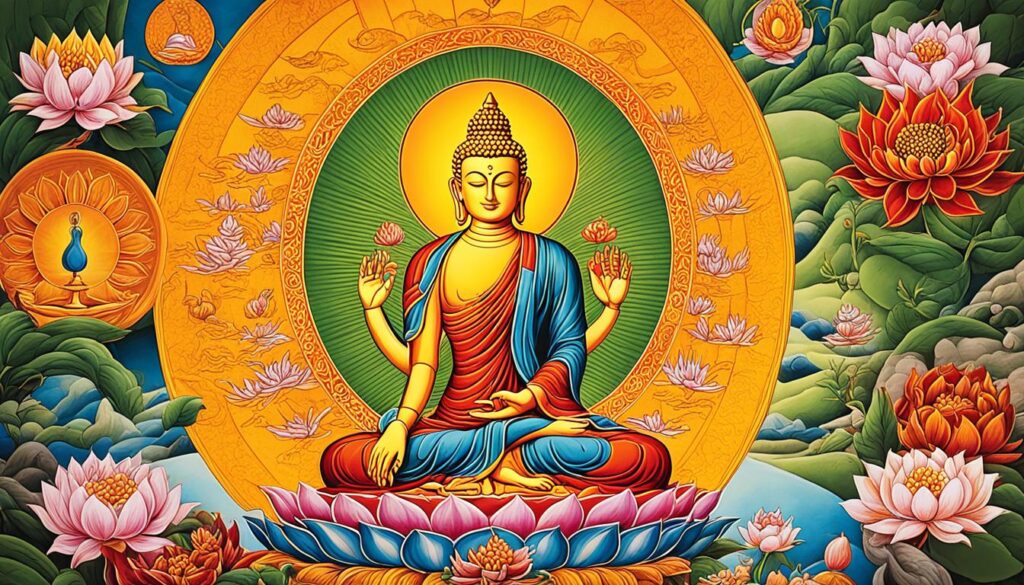
View of the Buddha
Both Theravada and Mahayana Buddhism hold the Buddha in high regard as a fully enlightened being. However, there are distinct differences in how the Buddha is viewed in each tradition.
In Theravada Buddhism, the Buddha is seen as a supreme teacher and a human being who achieved enlightenment through his own efforts and teachings. The emphasis is on following the Buddha’s teachings and striving for personal liberation from the cycle of samsara. The Buddha is revered as a guide and inspiration for individuals on their spiritual journey.
In contrast, Mahayana Buddhism expands the view of the Buddha to include additional buddhas and celestial beings. The historical Buddha, Siddhartha Gautama, is revered as the primary teacher and exemplar of enlightenment. However, Mahayana also recognizes the existence of other enlightened beings, such as bodhisattvas, who have chosen to delay their own enlightenment to assist others in attaining liberation. These bodhisattvas are seen as compassionate beings who guide and support individuals in their quest for enlightenment.
In Theravada Buddhism, the Buddha is revered as a supreme teacher and human being, while Mahayana Buddhism extends its reverence to include multiple enlightened beings.
It is important to note that both traditions hold the Buddha in deep reverence and regard his teachings as essential for spiritual growth and awakening.
For a visual representation of the different views of the Buddha in Theravada and Mahayana Buddhism, refer to the table below:
| Theravada Buddhism | Mahayana Buddhism |
|---|---|
| Emphasizes the Buddha as a supreme teacher and human | Recognizes multiple enlightened beings, including the historical Buddha and bodhisattvas |
| Focuses on individual liberation | Emphasizes compassion and the liberation of all beings |
Table: Contrasting views of the Buddha in Theravada and Mahayana Buddhism.
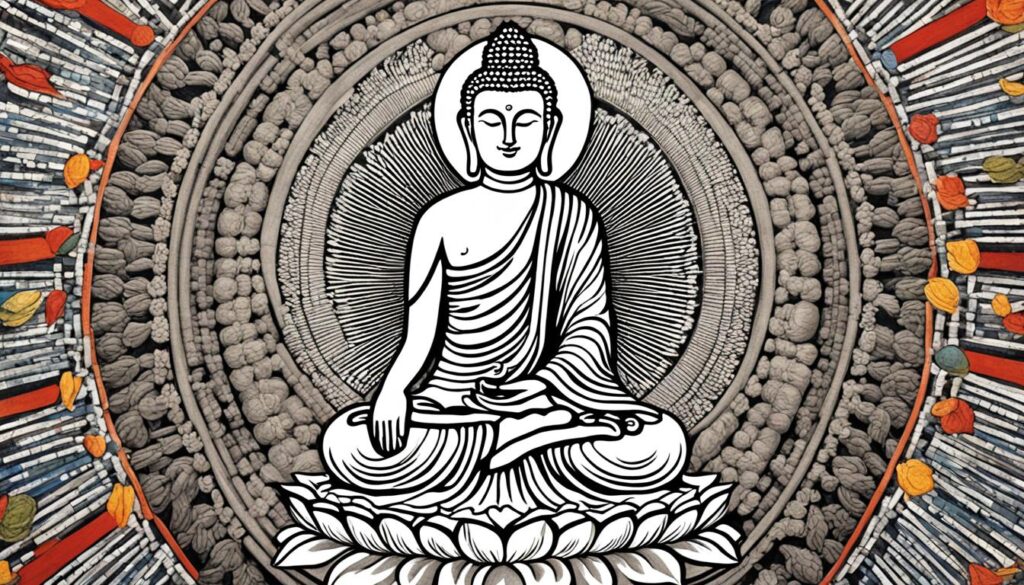
Rituals and Worship
In Theravada and Mahayana Buddhism, rituals and worship practices differ significantly.
In Theravada Buddhism, there is less emphasis on elaborate rituals and more focus on meditation and personal practice. The tradition values the individual’s direct experience and understanding of the teachings of the Buddha. Meditative practices are seen as a means of achieving enlightenment and liberation from suffering.
Mahayana Buddhism, on the other hand, places a greater emphasis on rituals and worship. Rituals such as chanting, bowing, and making offerings are common in Mahayana temples. Mantras and mudras (hand gestures) are also used as a way to connect with the divine and cultivate spiritual qualities.
These rituals and practices in Mahayana Buddhism are seen as a way to express devotion and cultivate the bodhisattva spirit, the aspiration to help all beings attain liberation.
The emphasis on rituals and worship in Mahayana Buddhism allows for a more outward expression of faith and devotion, involving the active participation of the community in temple ceremonies and celebrations.
Key Differences in Rituals and Worship between Theravada and Mahayana Buddhism
To better understand the contrasting approaches, let’s take a closer look:
| Theravada Buddhism | Mahayana Buddhism |
|---|---|
| Less emphasis on elaborate rituals | Greater emphasis on rituals and worship |
| Focus on meditation and personal practice | Incorporation of mantras and mudras in worship |
| Meditation as a means of achieving enlightenment | Expression of devotion and cultivation of the bodhisattva spirit |
While both Theravada and Mahayana Buddhism offer paths to liberation, the varying rituals and worship practices reflect the different cultural and historical contexts in which these traditions developed.
It’s essential to remember that the core teachings of Buddhism emphasize inner transformation and the cultivation of wisdom and compassion, regardless of the specific rituals and practices observed.
Now, let’s explore the concept of enlightenment in Theravada and Mahayana Buddhism in the next section.
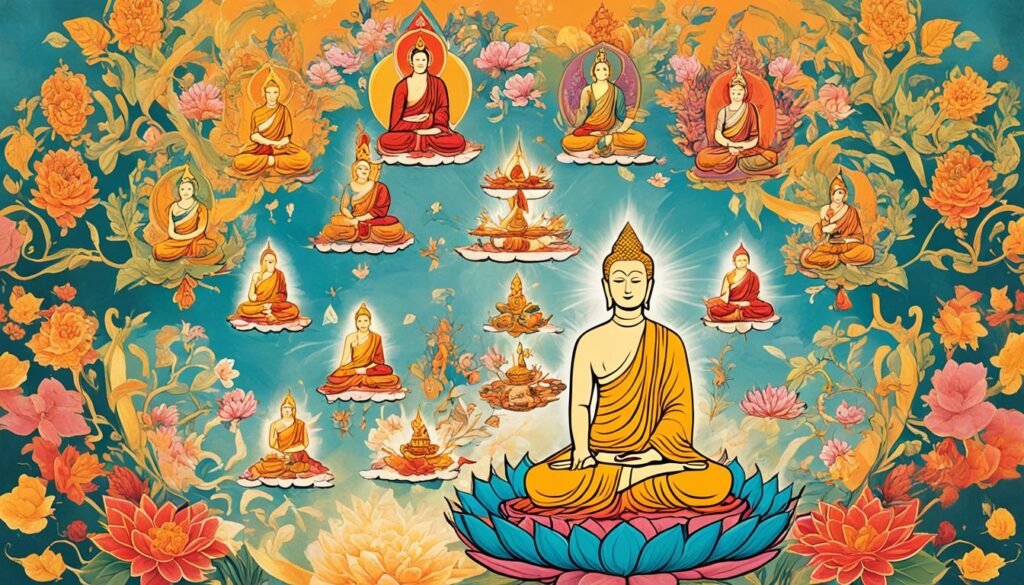
Role of Monasticism
Monasticism plays a significant role in both Theravada and Mahayana Buddhism. Monks and nuns dedicate their lives to the practice and teachings of Buddhism, embodying the principles of renunciation, discipline, and spiritual development. However, the role and significance of monasticism may vary between the two branches.
Monasticism in Theravada Buddhism
In Theravada Buddhism, monasticism holds a central position. Monks and nuns play a vital role as spiritual leaders and guardians of the Buddhist teachings. They follow a strict code of conduct known as the Vinaya, which guides their behavior, lifestyle, and practice. Through their dedication to meditation, study, and observance of precepts, they seek personal liberation from suffering and serve as exemplars for lay practitioners.
The monastic community, known as the Sangha, provides support and guidance to lay followers. They offer teachings, perform rituals, and serve as a source of inspiration and refuge. Monastics are highly venerated and respected for their renunciation of worldly attachments and their commitment to the path of liberation.
Monasticism in Mahayana Buddhism
In Mahayana Buddhism, monasticism also holds an important place, but the role and emphasis may differ from Theravada. While monasticism is practiced, Mahayana Buddhism places greater emphasis on the bodhisattva ideal, which encourages all beings to strive for enlightenment and work for the benefit of others.
Monks and nuns in Mahayana Buddhism may engage in a variety of practices and activities beyond traditional monastic duties. They may actively participate in social welfare, education, and community building. Some Mahayana traditions also recognize lay practitioners who undertake bodhisattva vows, blurring the distinction between monastics and lay followers in terms of spiritual commitment and service.
The Role of Monasticism
Monasticism in both Theravada and Mahayana Buddhism plays a vital role in preserving and transmitting the teachings of the Buddha. Monks and nuns serve as spiritual guides, supporting the spiritual development of others and upholding the monastic lineage.

Geographical Distribution
Theravada Buddhism is predominantly practiced in Southeast Asia, including countries like Sri Lanka, Thailand, and Cambodia. The teachings and practices of Theravada Buddhism have deeply influenced the culture and traditions of these regions, creating a strong presence and a rich heritage. The serene landscapes of these countries provide an ideal environment for practicing meditation and seeking spiritual enlightenment.
Mahayana Buddhism, on the other hand, has a broader geographical distribution, with significant followings in East Asia. China, with its vast population, has the largest number of Mahayana Buddhist practitioners, with temples and monasteries spread throughout the country. Tibet is known for its unique blend of Mahayana Buddhism and indigenous Tibetan beliefs, resulting in a distinct form of Buddhism known as Tibetan Buddhism. Japan and Korea also have thriving Mahayana Buddhist communities, with temples and monastic institutions playing an important role in the spiritual lives of their people.
The geographical distribution of Theravada and Mahayana Buddhism reflects the historical spread and adaptation of these traditions across different regions. Each branch has embraced local cultures while preserving the fundamental teachings of Buddhism, resulting in diverse expressions and practices that continue to inspire millions of people in their quest for enlightenment.
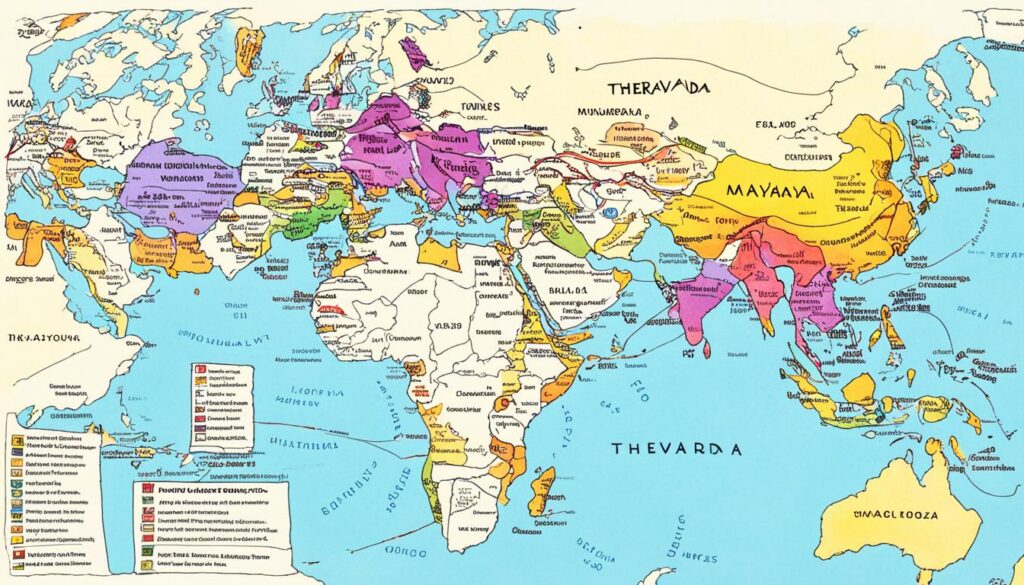
Influence and Adaptation
In the rich tapestry of Buddhism, both Theravada and Mahayana have been profoundly influenced by the cultures and civilizations they have encountered. These influences have shaped the development and adaptation of these two branches of Buddhism, allowing them to resonate with local customs and beliefs.
Theravada Buddhism: Adaptation to Southeast Asian Customs
Theravada Buddhism, primarily practiced in Southeast Asia, has seamlessly woven itself into the fabric of local societies. This branch of Buddhism has embraced and integrated indigenous customs and traditions, resulting in a unique and diverse expression of the faith.
For example:
- Theravada Buddhism in Thailand, known as Thai Buddhism, is known for its close association with Thai culture, with rituals and practices reflecting the influence of the country’s distinct customs and traditions.
- In Sri Lanka, Theravada Buddhism has adapted to incorporate elements of Sri Lankan culture, such as rituals related to agriculture and cultural celebrations.
- Cambodian Theravada Buddhism, also known as Khmer Buddhism, has merged with traditional Khmer practices, resulting in a synthesis of religious and cultural expressions.
Through adaptation, Theravada Buddhism has seamlessly integrated with the societies in which it has taken root, allowing practitioners to connect with Buddhist teachings on a deeply personal and cultural level.
Mahayana Buddhism: Integration of Eastern Philosophies and Beliefs
Mahayana Buddhism, widely practiced in East Asia, has encountered and incorporated various philosophical and religious systems throughout its evolution. This integration has enriched the Mahayana tradition, fostering a harmonious dialogue between different aspects of Eastern wisdom.
In East Asia, Mahayana Buddhism has been influenced by:
- Confucianism, which emphasizes moral values, social harmony, and filial piety. This influence is evident in the emphasis on ethical conduct and the cultivation of compassion within Mahayana Buddhist teachings.
- Taoism, with its focus on living in harmony with the natural flow of life. This influence can be seen in the contemplative and meditative practices of Mahayana Buddhism.
- Indigenous beliefs and folk traditions, which have contributed to the rich tapestry of local expressions of Mahayana Buddhism across different regions.
These influences have shaped the beliefs, practices, and rituals within Mahayana Buddhism, allowing it to evolve and resonate with the unique cultural and philosophical landscape of East Asia.

Contemporary Expressions
Theravada and Mahayana Buddhism have evolved over time, giving rise to contemporary expressions that continue to shape these traditions. Let’s explore some examples of these modern expressions:
1. Thai Forest Tradition
The Thai Forest Tradition is a contemporary expression of Theravada Buddhism that emphasizes meditation and the practice of mindfulness in natural forest settings. This tradition seeks to bring practitioners closer to nature and cultivate a deep sense of inner peace and tranquility.
2. Vipassana Meditation
Vipassana meditation, also known as insight meditation, is widely practiced in Theravada Buddhism. It involves observing the mind and body to gain insight into the nature of reality. This technique has gained popularity globally due to its effectiveness in developing mindfulness and self-awareness.
3. Pure Land Buddhism
In Mahayana Buddhism, Pure Land Buddhism is a contemporary expression focused on the belief in Amitabha Buddha and the Pure Land, a realm where enlightenment can be easily attained. Devotees chant Amitabha Buddha’s name as a form of practice, with the aspiration to be reborn in the Pure Land and ultimately achieve liberation.
4. Zen Buddhism
Zen Buddhism is a prominent contemporary expression of Mahayana Buddhism. It emphasizes direct experience and meditation, aiming to awaken individuals to their true nature and the inherent enlightenment within. Zen practice often involves silent meditation, koan (paradoxical statement) contemplation, and interaction with a Zen master.

These are just a few examples of the contemporary expressions within Theravada and Mahayana Buddhism. They showcase the adaptability and ongoing relevance of these traditions in the modern world. As Buddhism continues to spread and evolve, new expressions will likely emerge, providing practitioners with diverse paths to spiritual growth and enlightenment.
Conclusion
In conclusion, Theravada and Mahayana Buddhism exhibit significant differences in their scriptures, beliefs, practices, and perspectives on enlightenment and the role of bodhisattvas. Understanding these distinctions is crucial for individuals embarking on their spiritual journey and seeking to appreciate the diverse tapestry of Buddhism.
Theravada Buddhism, rooted in the Pali Canon, emphasizes personal effort and individual liberation from the cycle of rebirth. It emphasizes meditation, monasticism, and personal discipline as the path to enlightenment.
In contrast, Mahayana Buddhism encompasses additional texts and teachings and places greater emphasis on compassion and the bodhisattva ideal. Practitioners strive to attain enlightenment not just for themselves but also for the liberation of all beings.
By grasping the differences between Theravada and Mahayana Buddhism, individuals can gain a deeper understanding of the diverse approaches within Buddhism and navigate their own spiritual path. Whether one resonates with Theravada’s focus on personal liberation or Mahayana’s embrace of compassion and universal liberation, both branches offer profound insights and transformative practices.

